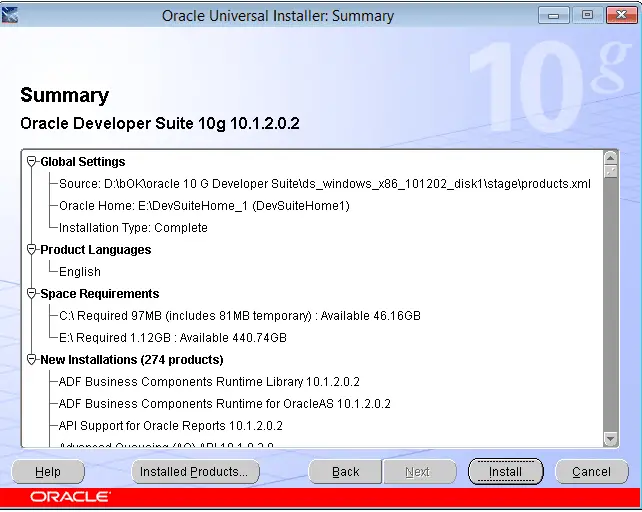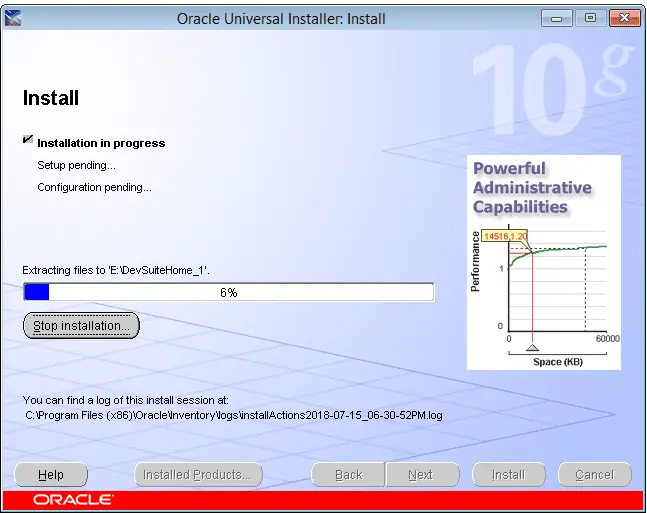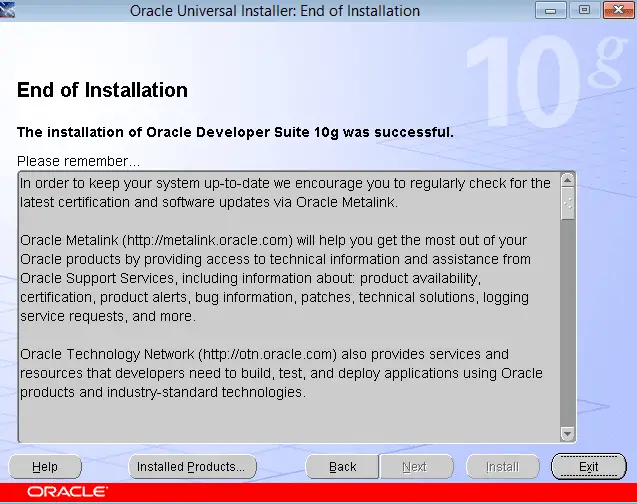Oracle Developer Suite 10G provides Forms Developer, Designer, Reports Developer, and Oracle 10g JDeveloper tools.
These tools let developers quickly build high-quality transactional applications, which can be deployed to multiple channels – including portals, Web services, and wireless devices, and which can be extended with business intelligence capabilities – including ad hoc query and analysis, high-quality Web reporting, and advanced analysis.
The installation of Oracle Developer Suite 10G On Windows is wizard-driven where Oracle Universal Installer presents screens with default options. Just select and click Next to install
Pre-requisite
Basic software installation knowledge of Microsoft Windows Operating System.
Software/Hardware
- Microsoft Windows 10/Windows 8/Windows 7
- Oracle Developer Suite 10G (10.1.2.0.2)
1. Download Oracle Developer Suite 10G
You can download the Oracle Developer Suite 10G from the Oracle Technology Network (OTN) site. Click on either of the below links to open the download page.
Next, Accept the License Agreement on this page. You need Oracle Account to download any software. If you do not have an account, you can create it here.

Download both the .zip files and extract these files on the local desk. There should be 2 folders one for disk1 and another for disk2.
- ds_windows_x86_101202_disk1.zip
- ds_windows_x86_101202_disk2.zip
2. Set compatibility mode and virtual memory
Oracle developer suite 10g is not supported on Windows 8/10 and higher versions. So you need to install it with compatibility mode, or else you will get the below error.
Checking operating system version: must be 5.0, 5.1 or 5.2. Actual 6.2 Failed
Exiting Oracle Universal Installer
Set compatibility mode
Open ds_windows_x86_101202_disk1 folder. Right-click on setup.exe. In the compatibility tab, select Windows XP Service Pack 3.
Set virtual memory
Right-click on Computer->Properties-> Advanced System Settings -> Virtual Memory. Uncheck automatic and set the value somewhere greater than 512 MB.
This avoids the below error in the later stage of installation.

3. Start Installation
Now double-click on setup.exe to start the installation. The Oracle Universal Installer does the quick requirement for Operating System and Virtual Memory and launches the setup wizard.
The welcome screen provides information about the Oracle Universal Installer. You can click Installed Products to see all installed products.

4. Specify File Locations
Specify file locations. By default, the installer populates the Source files and Destination installation folder. You can change it if required.

5. Select Installation Type
Choose what type of installation do you want?

J2EE Development – Provides a lightweight installation that allows you to develop Java and Enterprise Edition (J2EE) applications using Java, HTML, XML, and SQL.
Complete – Select this option to install Oracle Forms Developer, Oracle Designer, Oracle Reports Developer and Oracle10g JDeveloper. This option also installs Oracle Application Server Containers for J2EE (OC4J) and the relevant Oracle Application Server runtime services (Oracle Application Server Forms Services and Oracle Application Server Reports Services) and configures OC4J as the default listener for testing purposes
| Component | J2EE Development | Complete |
|---|---|---|
| Oracle10g JDeveloper (including Oracle Business Intelligence Beans, and UIX and Bali subcomponents) | YES | YES |
| Oracle Reports Developer | no | YES |
| Oracle Forms Developer | no | YES |
| Oracle Designer | no | YES |
Next step installer again Analyze Dependencies. You may get below virtual memory error if you have not set.
Install has encountered an error while attempting to verify your virtual memory setting. please verify that the sum of the initial size of the paging files is at least 256MB.
Here you need to change the Virtual Memory setting of the computer. Right-click on Computer->Properties-> Advanced System Settings -> Virtual Memory. Uncheck automatic and set the value somewhere greater than 512 MB.
6. Provide Outgoing Mail Server information
Enter Outgoing Mail Server information if you have one else leave it blank. Click on next.

7. Installation Summary
Below is a summary of the installation. Just verify and if you want to change click Back else click the Install button.

8. Continue Installation
This starts the installation process. The installer extracts all files and copies the required file to the system,

Select the OracleDevsuite Disk 2 folder by clicking on the Browse button.

9. End of Installation
Installation is complete. Just click on Exit and you are done.

Summary
In this tutorial, we covered how to install Oracle Developer Suite 10G on Windows 10. We are going to write some good articles on forms builder, keep visiting.
Reference –